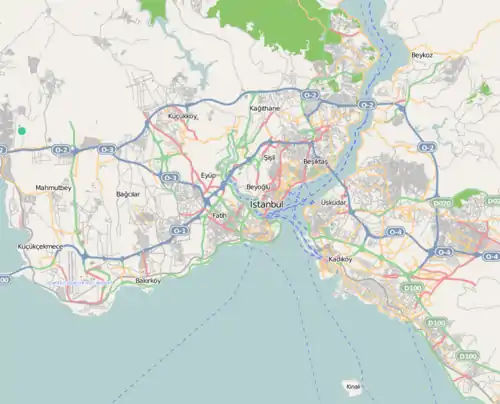Kurtuluş
Kurtuluş is a district of Istanbul, formerly known as Tatavla meaning "horse stable" (Greek: Ταταύλα). It lies within the cosmopolitan neighborhood of Şişli. Its population today is composed of Turks who moved there mostly after the Republic of Turkey was founded and became the large majority in the next decades, Greeks (now almost completely emigrated), Armenians (who still live there in numbers), Kurds (who are relatively recent economic migrants), and Jews (who still live there in numbers). The Turkish name means "liberation", "salvation", "independence" or "deliverance". It was originally well known as a predominantly Greek Christian neighborhood and later as a cosmpolitan neighborhood that included Turks, Armenians and Jews until the middle of the 20th century.
Kurtuluş | |
|---|---|
Neighborhood | |
 Kurtuluş Location of Kurtuluş in Istanbul | |
| Coordinates: 41.04845°N 28.98095°E | |
| Country | |
| Region | Marmara |
| Province | Istanbul |
| District | Şişli |
| Time zone | UTC+2 (EET) |
| • Summer (DST) | UTC+3 (EEST) |
| Postal code | 34375, 34377, 34379 |
| Area code | 0-212 |
History
The quarter was built in the 16th century as a residential area for Chian Greeks, settled here to work in the principal dockyards of the Ottoman Empire which were situated in the neighboring Kasımpaşa quarter. In 1832, a fire swept and completely destroyed the neighborhood, with 600 houses and 30 shops going up in flames. Tatavla emerged as an entirely Greek part of Istanbul, which during the 19th century reached a population of 20,000 and hosted several Orthodox churches, schools and tavernas;[1] it was nicknamed Little Athens because of its Greek character.[1] It was typically the residential area for Greeks of more modest income, as opposed to, for example, Tarabya on the Bosphorus, where richer Greeks as well as rich Turks and Europeans lived. Nevertheless, a number of beautiful houses were built in the late 19th century, some of which still stand today. A vivid description of pre-First World War Tatavla is to be found in Maria Iordanidou's 1963 novel Loxandra, which is based on the experiences of her grandmother.[2]
Kurtuluş was also the place that ended the Baklahorani carnival procession, an annual event led by the Greek community of the city. This was banned by the Turkish authorities in 1943, but was revived in 2010.[3]
On 13 April 1929, six years after the Republic of Turkey was founded, a fire swept through the neighborhood and largely destroyed it, with 207 houses going up in flames. Its name was changed to Kurtuluş to mark its rebuilding, and symbolizing its rejuvenation. Despite the turmoil of the Balkan War, followed by World War I and the following Greco-Turkish War (1919–1922) and the devastating fire, the neighborhood continued to retain a large Greek population and atmosphere (and a significant Armenian and Jewish population), at least until the riots of 1955.
References
- Didem Danis, Ebru Kayaalp. "Elmadag: A Neighborhood in Flux" (PDF). Institut Français D'Etudes Anatoliennes GEORGES DUMEZIL. p. 19. Archived from the original (PDF) on 1 March 2012. Retrieved 16 December 2011.
- Loxandra, English translation 2017, by Maria Iordanidou, pub. Harvey, pp. e.g. 26-28
- Mullins, Ansel. "Reviving Carnival in Istanbul". New York Times. Retrieved 1 November 2011.
External links
- Şişli Belediyesi (Şişli Municipality). Tarihçe (Brief history). https://web.archive.org/web/20100302202602/http://www.sislibelediyesi.com/yeni/sisli/t1.asp?PageName=tarihce Retrieved 15 September 2009.
- A Journey through Kurtuluş, a Mirror of Turkey Old and New, Evan Pheiffer, 2 April 2020. https://www.resetdoc.org/story/a-journey-through-kurtulus/. Retrieved 16 October 2020.